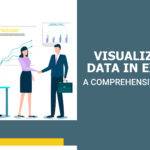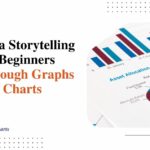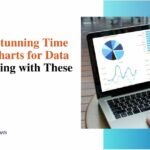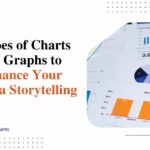The Art of Data Interpretation: Turning Data into Compelling Stories
We are living in an era of big data. Organizations across all industries collect vast amounts of data about their customers, products, processes, and more. However, more than simply having access to data is required. The true value comes from correctly interpreting this data and using insights to inform business decisions and strategies.
Data interpretation is analyzing data, identifying meaningful patterns and relationships, and communicating these findings clearly and engagingly. Using effective storytelling techniques, data interpreters can turn raw numbers into compelling narratives that drive action.
Understanding Data Interpretation

While related, data interpretation differs from data analysis and visualization. Data analysis involves collecting, cleaning, and processing data using statistical and programming techniques to derive quantitative insights. Data visualization focuses on visually representing data through charts, graphs, and dashboards to reveal patterns at a glance.
Data interpretation builds upon these foundational processes but takes it further by placing the insights within relevant contexts and crafting them into stories. The goal is not just to present facts but to tell a meaningful story that causes the audience to think, feel, and act differently based on the revelations from the data.
The Role of Context in Data Interpretation
Providing appropriate context is key to effective data interpretation. Context helps audiences understand why certain insights matter and how they can be actioned. Some context elements to consider include the objectives of the analysis, assumptions made, data limitations, metrics definitions, comparisons to benchmarks or past performance, and external factors that may have influenced trends.
The right context level transforms isolated facts and findings into coherent narratives that audiences can easily relate to and learn from. It allows them to place the data interpretation within their own frame of reference for maximum impact.
Steps to Turn Data into Compelling Stories
The process of transforming raw data into compelling stories typically involves the following steps:
1. Identifying Key Insights
The interpreter begins by analyzing the data using tried-and-true analysis methods to identify patterns, relationships, outliers, and variations that warrant further exploration. They strategically focus on the two or three most significant and actionable insights rather than overwhelming the audience with details.
2. Crafting a Compelling Narrative
With the key takeaways in mind, the interpreter crafts a narrative structure with a beginning, middle, and end to tell a cohesive story. They hook the audience with an attention-grabbing opening, build tension by presenting evidence for the insights, and provide resolution through clear calls to action. Compelling narratives personalize cold, hard facts through vivid examples, relatable quotes, and an engaging writing style.
3. Visualizing Data Effectively
Visual representations like graphs, plots, and dashboards are selected or created based on specific insights to maximize understandability and story flow. Visuals draw audiences in, break up blocks of text, and help different types of learners comprehend key messages more easily. Formats like infographics are also useful for communicating findings across various channels and on social media.
4. Communicating Insights
The interpreter delivers the interpretation through written, oral, and digital formats suitable for the intended audience and objective. They avoid jargon, explain concepts, and facilitate two-way dialogue to ensure full comprehension and buy-in for recommended actions. Feedback is continuously incorporated to improve future interpretation efforts.
Tips for Effective Data Interpretation and Storytelling
Here are some additional tips for producing compelling data stories:
- Focus on a narrow scope to give depth of understanding rather than breadth. Tell one good story well.
- Use storytelling techniques like setting the scene, developing characters, and creative sequencing to capture and hold attention.
- Incorporate diverse interpretation methods like data dramatization, visual analogies, and role-playing to cater to varying learning styles.
- Test interpretations on colleagues to refine the narrative based on their reactions and perspectives.
- Clearly call out “so what” takeaways and recommended actions at the conclusion for maximum impact.
- Revise interpretations to incorporate new insights as analysis and data evolve over time. Stories should be living documents.
Future Trends of Data Interpretation
The field of data interpretation is continuously evolving to address the changing data landscape. Here are some significant trends that can be expected to shape how insights are derived and stories are told in the upcoming years:
Leveraging Predictive Analytics
- With trends in predictive modeling: Data interpreters will increasingly rely on predictive analytics techniques like machine learning and advanced modeling of past data patterns to generate forecasts of future outcomes. These predicted insights and a probability range will allow stakeholders to develop strategic contingency plans.
- Augmenting interpretation capabilities: Interpreters can augment their work by leveraging predictive algorithms to generate “what if” scenarios – like what could happen if a certain variable is altered. This helps interpreters identify overlooked relationships and sensitivities in the data for a more thorough evaluation.
Immersive Data Storytelling
- Visual storytelling evolution: Virtual and augmented reality technologies will enhance data stories by bringing them to life through immersive 3D environments and interactive simulations. This makes complex learning more engaging and memorable.
- Beyond slides and reports: Interpreters will craft custom virtual and interactive story worlds in which readers can explore different possibilities in a simulated setting. This will establish a new dimension of connection and empathy with stakeholders.
Democratizing Data Literacy
- Making interpretations accessible: As data becomes increasingly democratized, interpreters must find novel ways to present insights simply and contextually to various audiences, from the C-suite to frontline workers and the general public.
- Multi-format distribution: Formats like social audio, video, infographics, and animation will become the core of disseminating stories and catalyzing widespread data literacy. Interpreters need proficiency across mediums.
Expanding Role and Recognition
- Specialized data storytelling careers: As data volumes explode, full-time data interpreter roles bridging analysis and storytelling are emerging. Formal credentials and university programs will legitimize this domain.
- Business-wide impact: With their abilities to incite compelling visions, interpreters will shift from support to driving key strategic decisions and initiatives through recommendations fed by deep data understanding.
The Bottom Line
The ability to extract compelling stories and meaningful insights from numbers will determine which organizations can truly capitalize on their data assets in today’s digital age. Continuous enhancement of interpretation methodologies, alongside creative storytelling skills, will bring data to life in a way that influences mindsets and drives impactful actions.
Those who invest in developing these sophisticated yet accessible talents will gain an unmatched competitive advantage in both business and society.







